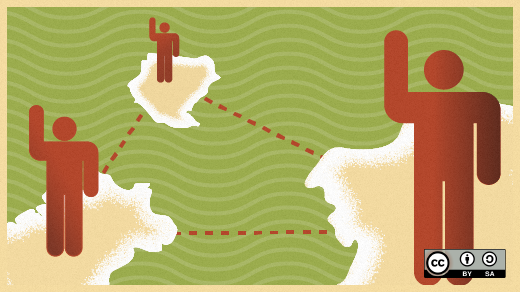Open source projects thrive because of their communities. It makes sense that community management is a big topic on Opensource.com. This year, we had several good articles looking at different aspects of communities and how they’re started, protected, and nurtured.
Why program management matters in open source
In this article by Ben Cotton, he reminds you that as community projects grow and become more complex with multiple product owners and contributors, so does the need for a program manager. Open communication about deliverables, expectations, and road maps is important to help keep the goal and intentions focused. There are always spaces for collaboration and discussion, and the program manager can help the community avoid surprises.
Create a more diverse and equitable open source project with open standards
In Paloma Oliveira's article, you are reminded that using the concept of open standards in projects will lead to better communication. Open standards help build communication between the creators and the end users. They can also serve as an accessible entry point for new contributors. The use of clear communication helps folks feel welcome, want to start contributing, and can attract more diverse contributors to your project.
Build an open source project using this essential advice
Bolaji Ayodeji's article outlines the lifecycle of an open source project and provides tips on how to structure the project for sustainability. A project can be broken into two main parts: people and their roles and documents to help set collaboration standards. The article concludes with Ayodeji's 13 phases of an open source project and how you can use the list as a starting point for creating your project.
Attract contributors to your open source project with authenticity
There are plenty of great open source projects, but how do you make people aware of your project and attract contributors? Rizel Scarlett's article outlines seven avenues to promote a project without feeling "marketing-y." There is also advice about ensuring the project is easy to find, use, and contribute to. Even if the project lacks momentum, remember to keep contributing because people are drawn to an active project.
Put Design Thinking into practice with the Open Practice Library
This article is a collaborative piece by Leigh Griffin, Stefan Mattejiet, and Aoife Moloney. It's the first in a series of articles that introduces the concept of Design Thinking and how you can achieve it through the Open Practice Library (OPL), a resource for open source practitioners. All humans learn in different ways. Design Thinking breaks down different learning styles and ensures that people's needs are met. It also demonstrates that they can be successful in a team.
Build community engagement by serving up Lean Coffee
This article by 2022 Aaron Winborn Award Winner Angie Byron outlines how folks can incorporate Lean Coffee into their organizations. This allows for more collaborative meetings through remote team building and asynchronous topic discussion. Lean Coffee allows co-workers or collaborators to get to know each other, engage, find common interests, and ultimately learn from each other.
5 levels of transparency for open source communities
This article by Georg Link, Anirudha Jadhav, and Emilio Galeano Gryciuk visits why you need transparency in open source communities. When maintainers, collaborators, and end users trust one another, it creates a space where people can message and have discussions in the open. Transparency helps avoid friction, allows metrics to be exchanged for product owner buy-in, and encourages trust when people know what exact metrics are shared.
A guide to productivity management in open source projects
Thabang Mashologu's article stresses the importance of openness, transparency, and putting them into practice. Thabang encourages collaboration and productivity on open source teams through the SPACE model: satisfaction and well-being, performance, activity, communication and collaboration, and efficiency and flow.
Balancing transparency as an open source community manager
This article uses a gardening metaphor to help explain open source cultivation. Rich Bowen says that a community manager is much like a community gardener. Sometimes community managers have upstream and insider information that cannot be disclosed to other contributors. But helping keep the "garden" tended, watered, and free of weeds can help cultivate a trusting community.
How we track the community health of our open source project
The use of CRM Savannah has helped some communities track different aspects of community metrics. Ruth Cheesley's article explains how the CRM allows the Mautic community to collect and store information in a central place. Not only can the CRM track where the contributions are happening, but it also tracks community contributions over time. Unlike many tools using Savannah, the Mautic community can highlight the folks who empower others before they contribute. This practice often encourages novices to make contributions in the future.
Open source events: 4 goals to set and how to measure them
In this collaborative piece by Shaun McCance, Neofytos Kolokotronis, Georg Link, Sri Ramkrishna, and Nuritzi Sanchez, you learn that while you can have successful events, it's essential to understand what makes an event successful. Several goals are identified so quantifiable metrics can be measured. There are four goals: Retain and attract contributors, have engaging events, understand company contributions, and address diversity and skill gaps.
How to make community recognition more inclusive
This article by Ray Paik is a good reminder of how you should look beyond metrics when giving recognition in communities. Metrics are great for code contributions and providing numbers for the product owner's buy-in. But they often leave out meaningful contributions beyond code (documentation, design, ideation, and so on), which can leave contributors feeling left behind. When communities make recognition more meaningful and impactful, it helps build community trust, leading to more community engagement.
Open communities
Open source is a community project. It never happens in a vacuum, and it grows because of the communities that form around it. Whether you interact with open source as a user, contributor or both, you're part of a community, and the community is better for it.







Comments are closed.